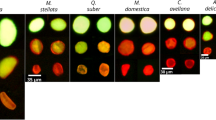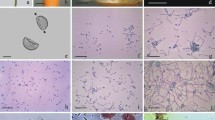Abstract
Long-distance dispersal (LDD) theory requires a method for marking live LDD pollen. Such a method must complement more intensive sampling methods inclusive of molecular cytogenetics, proteomics and genomics. We developed a new method for marking live Pinus taeda pollen using two dyes, rhodamine 123 and aniline blue, dissolved in a sucrose solution. Marked and unmarked pollen were compared with respect to in vitro germination, storage, terminal velocity, and in vivo pollen tube penetration of ovules. We found that: (1) both types of marked pollen retained their capacity for germination, (2) both types of marked pollen had similar aerodynamic properties when compared to unmarked pollen controls, (3) marked pollen retained its germination capacity for 48 h, and (4) of the marked pollen, only the aniline-marked pollen penetrated ovules during pollination. Germination declined rapidly for both types of marked pollen after 48 h and before 37 days at −20°C storage, while unmarked pollen lots retained 93% germination at all stages. This method for marking live P. taeda pollen is feasible for tracing LDD pollen only if released and deposited within 48 h of dye treatment.

Similar content being viewed by others
References
Aitken SN, Yeaman S, Holliday JA, Wang T, Curtis-McLane S (2008) Adaptation, migration or extirpation: climate change outcomes for tree populations. Evol Appl 1:95–111
Alexander MP (1969) Differential staining aborted and nonaborted pollen. Stain Technol 41:117–122
Austerlitz F, Dick CW, Dutech C, Klein EK, Oddou-Muratorio S, Smouse PE, Sork VL (2004) Using genetic markers to estimate the pollen dispersal curve. Mol Ecol 13:937–954
Aylor DE (2002) Settling speed of corn (Zea mays) pollen. J Aerosol Sci 33:1601–1607
Bohne G, Woehlecke H, Ewald R (2005) Water relations of the pine exine. Ann Bot 96:201–208
Brown SD, Bridgwater FE (1987) Observations on pollination in loblolly pine. Can J For Res 17:299–303
Campbell ID, McDonald K, Flanigan MD, Kringayark J (1999) Long-distance transport of pollen into the Arctic. Nature 399:29–30
Colwell R (1951) The use of radioactive isotopes in determining spore distribution patterns. Am J Bot 38:511–523
DiGiovanni F, Kevan P (1991) Factors affecting pollen dynamics and its importance to pollen contamination: a review. Can J For Res 21:1155–1170
Eisenhut G (1961) Untersuchungen über die Morphologie und Okologie der Pollenkörner heimischer und fremdländischer Walbäume. Forstwiss Forsch 15:1–68
Evans N, Hoyne P (1982) A fluorochrome from aniline blue: structure, synthesis and fluorescence properties. Aust J Chem 35:2571–2575
Goddard R, Matthews F (1981) Pollen testing. In: Franklin EC (ed) Pollen management handbook (Agricultural Handbook no. 587). Government Printing Office, Washington, DC, pp 40–43
Greenwood MS (1986) Gene exchange in loblolly pine: the relation between pollination mechanism, female receptivity and pollen availability. Am J Bot 73:1443–1451
Hamrick JL (2004) Response of forest trees to global environmental changes. For Ecol Manag 197:323–335
Ito M, Susama Y, Ohsawa TA, Watano Y (2008) Airborne-pollen pool and mating pattern in a hybrid zone between Pinus pumila and P. parviflora var. pentaphylla. Mol Ecol 17:5092–5103
Jett JB, Bramlett DL, Webber JE, Eriksson U (1993) Pollen collection, storage and testing. In: Bramlett DL (ed) Advances in pollen management (Agricultural Handbook no. 698). Government Printing Office, Washington, DC, p 101
Katul GG, Poporato A, Nathan R, Siqueira M, Soons MB, Poggi D, Horn HS, Levin SA (2005) Mechanistic analytical models for long-distance seed dispersal by wind. Am Nat 166:368–381
Katul GG, Williams CG, Siqueira M, Poggi D, Porporato A, McCarthy H, Oren R (2006) Dispersal of transgenic conifer pollen. In: Williams CG (ed) Landscapes, genomics and transgenic conifers. Springer, Dordrecht, pp 121–143
King JR (1959) The freeze drying of pine pollen. Bull Torrey Bot Club 86:383–386
Kostia S, Varvio SL, Vakkari P, Pulkinen P (1995) Microsatellite sequences in Pinus sylvestris. Genome 38:1244–1248
Kuparinen A (2006) Mechanistic models for wind-dispersal. Trends Plant Sci 6:296–301
Leslie AB (2010) Flotation preferentially selects saccate pollen during conifer pollination. New Phytol 188:273–279
Matthews FR, Blalock TE (1981) Loblolly pine grains by ovule dissection. In: Proc 16th Southern Forest Tree Improvement Conf, Blacksburg, USA, 27–28 May 1981, pp 276–278
Parducci L, Suyama Y, Lascoux M, Bennett KD (2005) Ancient DNA from pollen: a genetic record of population history in Scots pine. Mol Ecol 14:2873–2882
Regan SM, Moffatt BA (1990) Cytochemical analysis of pollen development in wild-type Arabidopsis and a male-sterile mutant. Plant Cell 2:877–889
Rousseau D-D, Schevin P, Duzer D, Cambon G, Ferrier J, Jolly D, Poulsen U (2006) New evidence of long distance pollen transport to southern Greenland in late spring. Rev Palaeobot Palynol 141:272–286
Smouse PE, Robledo-Arnuncio JJ, Gonzalez-Martinez SC (2007) Implications of natural propagule flow for containment of genetically modified forest trees. Tree Genet Genomes 3:141–152
Snedecor GW, Cochran WG (1978) Statistical methods, 6th edn. Iowa State University Press, Ames
Takaso T, von Aderkas P, Owens JN (1996) Prefertilization events in ovules of Pseudotsuga: ovular secretion and its influence on pollen tubes. Can J Bot 74:1214–1219
Vannini GL, Pancaldi S, Poli F, Fasulo MP (1988) Rhodamine 123 as a vital stain for mitochondrion of plant cells. Plant Cell Environ 11:123–127
Watrud LS, Lee EH, Fairbrother A, Burdick C, Reichmann JR, Bollman M, Storm M, King G, van der Water PK (2004) Evidence for landscape-level, pollen-mediated gene flow from genetically modified creeping bentgrass with CP4 EPSPS as a marker. Proc Natl Acad Sci USA 101:14533–14538
Williams CG (2008a) Selfed embryo death in Pinus taeda: a phenotypic profile. New Phytol 178:210–222
Williams CG (2008b) Aerobiology of Pinus taeda pollen clouds. Can J For Res 38:2177–2188
Williams CG (2009) Conifer reproductive biology. Springer, New York
Williams CG (2010) Long-distance pine pollen still germinates after meso-scale dispersal. Am J Bot 97:1–10
Acknowledgments
Our work was supported by the Canada–US Fulbright Program, the Centre of Forest Biology at the University of Victoria, and in part by the USDA Biotechnology Risk Assessment Grants Program, grant number 2005-03804. Our experiments comply with the laws of the United States and Canada. The authors thank Rebecca Wagner, University of Victoria, BC, Canada for her histological expertise. We also thank Dana Nelson, Tom Kubisiak, and Floyd E. Bridgwater (retired) at the USDA Forest Service, Saucier, MS, USA for laboratory use.
Author information
Authors and Affiliations
Corresponding author
Additional information
Communicated by Rebecca Irwin.
Rights and permissions
About this article
Cite this article
Williams, C.G., von Aderkas, P. Marking live conifer pollen for long-distance dispersal experiments. Oecologia 165, 255–260 (2011). https://doi.org/10.1007/s00442-010-1825-8
Received:
Accepted:
Published:
Issue Date:
DOI: https://doi.org/10.1007/s00442-010-1825-8




